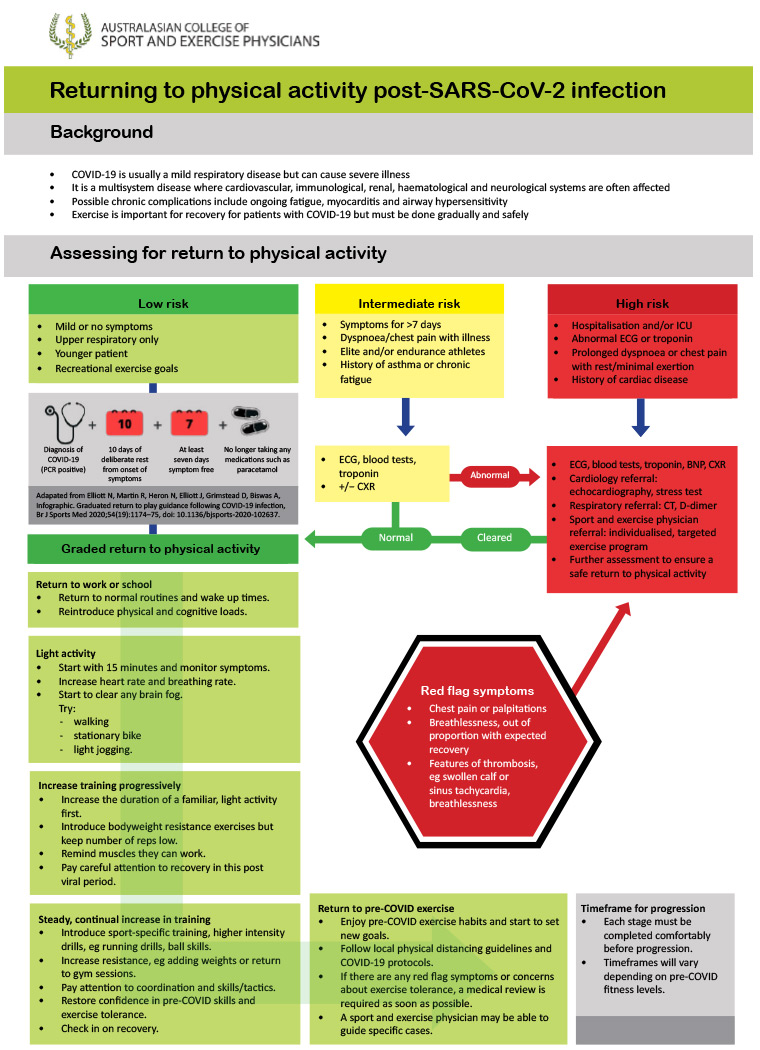Article Notes
- Semi-rigid cup type (3M 1860 or 1860S): 65% FT pass.
- Duckbill type: (BSN ProShield or Halyard Fluidshield): 59% FT pass.
- Flat-fold cup type: (BYD Care DE2322): 32% FT pass.
Low: Under 50 years with mild illness resolving within 7 days.
Intermediate: prolonged symptoms (>7d); persistent SOB or chest pain; pre-existing comorbidities; elite/endurance athletes.
- Consider ECG & baseline pathology, including troponin.
High: hospitalised with COVID; SOB or chest pain at rest; cardiac abnormalities.
- Multi-disciplinary team to advise & monitor return to exercise.
- Begin after 10 days of rest and when 7 days symptom-free.
- Begin with 15 minutes of light activity, with gradual increase guided by lack of fatigue with activity.
- 🚩Red flag symptoms: chest pain, palpitations, severe dyspnoea. STOP & medical review.
Excellent audit data from a major Australian teaching hospital reporting on the fit test results of their tested 2,161 healthcare workers across four different N95/P2 mask designs.
Why is this important?
Many healthcare workers and significantly, the general public, do not have access to formal Fit Testing (requires expertise, facilities & equipment). We also know that as face shape varies among individuals, so does the effectiveness of protection for different mask types – this is particularly significant for women who have more difficulty in finding suitably-fitting N95 respirators. (Notably 73% of Fit Tested staff in this study were women.)
The results of this study may allow individuals to make educated choices on suitable masks even when they do not have access to Fit Testing, as well as guiding institutional mask purchases.
What did they find?
Three-panel flat-fold N95 masks performed best (3M Aura 9320A+) both for fit test (96% pass) and wearer comfort and usability.
The other three tested designs were not as performant:
Jewson, McNamara & Fitzpatrick describe a roadmap for return to activity after COVID infection, developed by the Australasian College of Sport and Exercise Physicians.
They consider three risk categories:
Graded return to physical activity
Return to exercise flowchart:
Early in the COVID pandemic, diagnostic testing relied entirely on precise-but-expensive PCR testing. Late in 2020 the Lateral Flow Testing techniques, already widely used for home-pregnancy tests and similar, were developed for SARS-CoV-2 antigens, leading to COVID-19 Rapid Antigen Tests (RATs).
While cheap, scalable and able to give a result in 10-15 minutes, they were initially seen mostly as a supplement to PCR testing, with less accuracy. Although true that RATs have lower sensitivity than SARS-CoV-2 PCR – most licensed-RATs have sensitivity 80-95% – today this is both less important, and possibly even a strength of RATs over PCR.
Early in the pandemic the role of testing has primarily about diagnosis, in those either symptomatic or pre-symptomatic. Viral presence was practically assumed to be synonymous with contagion. Today with over half a billion cumulative COVID cases worldwide and counting, along with access to effective vaccines and antivirals, it is often more useful to know whether an individual is infectious or not at a discrete moment in time.
Growing research over the last 12 months shows that adequately-sensitive RATs are effective at identifying infectious individuals, even if the high-sensitivity of PCR testing identifies viral particles in those who are infected but otherwise non-infectious (either pre-infectious, or post-infectious with ongoing viral shedding).
PCR positive results with cycle thresholds (ie. number of thermal cycles of RNA replication required before fluorescence is detected) above 25-30 have good correlation with being non-infectious (ie. unable to culture virus). Adequately approved & validated RATs (by FDA, TGA, MHRA, etc.) have very high sensitivity at CT less than this 25-30 range, depending on the study and specific manufacturer.
The bottom line...
An adequately-validated RAT, when correctly performed, is likely a sensitive indictor of individual infectiousness at that specific moment in time. The reliability of a negative RAT will be improved if using the same manufacturer and technique as a RAT previously positive test, and more so if there are several subsequent negative RATs.
This study is primarily an evaluation of a specific RAT, the Coris coronavirus disease 2019 Ag Respi-Strip test – which while showing poor sensitivity, it again demonstrates that RAT-positivity correlates with viral load. This study used PCR-detection as the gold standard for evaluation, which because of the extreme sensitivity of PCR testing, does not easily translate to assessment of contagiousness (although Ct > 25-30 seems to correlate with inability to grow in viral culture).
